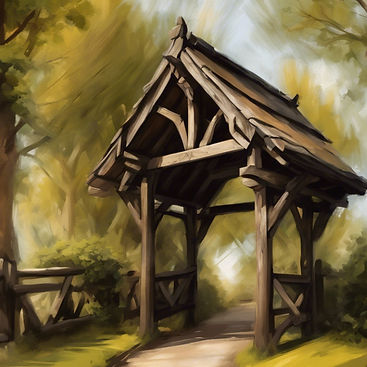
Lychgate
The word 'lych' is derived from the Old English word for corpse. These 'corpse' gates are found outside many churches, and look like covered shelters surrounding the entrance gate.
In the Middle Ages, long before the common use of mortuaries, the lychgate was somewhere the dead could be sheltered before a burial. The protected the corpse from the elements and gave family somewhere to gather before the burial.

In a time when most people died at home, they would usually be placed on a bier - a type of cart designed to carry a corpse or coffin - and conveyed from their homes or place of death to the church. The dead, often shrouded rather than in a coffin, would be placed in the lychgate until burial the following day. Occasionally they would be there more than a day until the burial could take place, though usually only by a day or so. Without the preservation skills of morticians it was important to bury the corpse as soon as possible after death.
Some lychgates also had seating built into the side so that people could keep vigil until the burial. The position of the lychgate on the boundary of the churchyard also represented a transitional space between unconsecrated and consecrated ground. It was part of the corpse's journey being welcomed into the care of God.
Their traditional use started to fall out of use in the 18th century, and as society moved toward mortuaries, body-snatchers, and funeral directors, this simple ritual became obsolete.
Many of the original Medieval examples have long since deteriorated and been lost, but there are survivors still to be found, along with many beautiful Victorian rebuilds - many in a medieval renaissance style.


